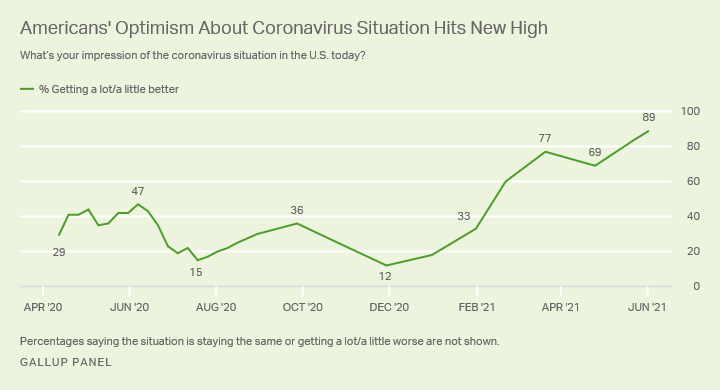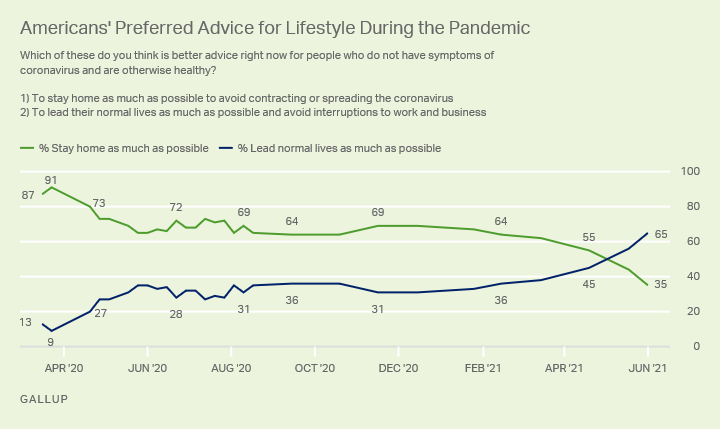Story Highlights
- 29% say pandemic is done; 71% say it is not
- 62% say lives "somewhat" back to normal; 54% say lives not disrupted now
- 40% do not expect their lives will ever be normal again
WASHINGTON, D.C. -- Although a record-high 89% of Americans now say the coronavirus situation is improving, most are not yet ready to declare the pandemic over in the U.S. More than twice as many think the pandemic is not yet over (71%) than think it is over (29%). Republicans are far more likely than Democrats to say the pandemic is over, but significant differences also exist by gender, age and region of the country.
| Yes, pandemic is over | No, is not over | |
|---|---|---|
| % | ||
| U.S. adults | 29 | 71 |
| Gender | ||
| Male | 36 | 64 |
| Female | 22 | 78 |
| Party identification | ||
| Republican | 57 | 43 |
| Independent | 35 | 66 |
| Democrat | 4 | 96 |
| Age group | ||
| 18-34 years old | 24 | 76 |
| 35-54 years old | 32 | 68 |
| 55 and older | 30 | 70 |
| U.S. region | ||
| Northeast | 23 | 77 |
| Midwest | 31 | 69 |
| South | 31 | 69 |
| West | 28 | 72 |
| GALLUP PANEL, Jun. 14-20, 2021 | ||
These findings are from Gallup's June 14-20 probability-based web panel survey, which was conducted as increased vaccinations in the U.S. resulted in declining COVID-19 cases, hospitalizations and deaths. These developments are likely instrumental in the public's growing belief that the coronavirus situation is getting "a lot" (46%) or "a little" better (43%).

Line graph. Percentages of Americans who think the coronavirus situation in the U.S. is getting a lot or a little better since April 2020. Currently, 89% of U.S. adults say it is getting better, the highest on record.
Americans Report Fewer Disruptions, Increased Return to Normalcy
With pandemic-related restrictions in most states now lifted, the amount of disruption Americans see in their everyday lives continues to decline. Less than half of U.S. adults, 46%, currently say their lives are affected "a great deal" or "a fair amount," but more, 54%, consider their lives to be "not much" or "not at all" disrupted.
| April 19-25 | May 18-23 | Jun 14-20 | |
|---|---|---|---|
| % | % | % | |
| A great deal/A fair amount | 56 | 52 | 47 |
| Not much/Not at all | 44 | 48 | 53 |
| Gallup Panel, 2020 | |||
Likewise, Americans are increasingly reporting a return to some semblance of normalcy in their lives. While 15% of U.S. adults say their life is "completely back to normal," 62% describe their life as "somewhat" but not completely normal, and 23% say it is "not yet back to normal." Moreover, the percentage of U.S. adults who report that normalcy has not been restored in their lives has shrunk by 11 percentage points since May.
| Oct 19-Nov 1 | May 18-23 | Jun 14-20 | |
|---|---|---|---|
| % | % | % | |
| Completely back to normal | 3 | 9 | 15 |
| Somewhat back to normal, but not completely normal | 34 | 57 | 62 |
| Not yet back to normal | 62 | 34 | 23 |
| Gallup Panel, 2020-2021 | |||
Mixed Expectations for Return to Pre-Pandemic Normalcy
In addition to the 15% of U.S. adults who say their lives are already completely back to normal, 46% think their lives will eventually be. However, 40% of Americans do not expect that their lives will ever return entirely to the normal that existed prior to the pandemic.
| U.S. adults | |
|---|---|
| % | |
| Will get back to normal | 46 |
| Never get back to normal | 40 |
| Already completely back to normal* | 15 |
| *Question was not asked of those who said in a prior question that their lives were already completely back to normal | |
| Gallup Panel, June 14-20, 2021 | |
Among those who expect their lives to return to normalcy, slightly more (53%) think it will not come until sometime in 2022 or after that, while 47% anticipate normalcy in the next few weeks or months.
At the same time, a diminished majority of Americans, 53%, expect the level of disruption occurring to travel, school, work and public events in the U.S. will continue through the end of 2021 or longer than that, marking a nine-point drop since mid-March. Fewer, 47%, now say they expect the degree of disturbance in society to last a few more weeks or months.
More Americans Think Return to Normalcy Is Best for Healthy People
In May, a majority of Americans said for the first time that the better advice for healthy people is to lead their normal lives as much as possible to avoid interruptions to work and business rather than staying home to avoid contracting or spreading COVID-19. That majority has grown from 56% to 65% in June. Currently, 35% of Americans think it is better to stay home, roughly half of what it was in late December/early January.

Line graph. Trend from March 2020 to June 2021 in Americans' view that the better advice for healthy people during the pandemic is to stay home as much as possible to avoid contracting or spreading the coronavirus, rather than to lead their normal lives as much as possible. The percentage recommending staying home as much as possible has declined from a high of 91% last March to 35% today.
Bottom Line
Now that nearly two-thirds of U.S. adults have received at least one dose of the vaccine against COVID-19 and most facets of everyday life have reopened, Americans increasingly see less disruption in their lives and feel a sense of normalcy returning. However, for the most part, they think the pandemic is still ongoing. Given the quick-changing developments across the U.S., this judgment could soon change. Yet, like many aspects of the pandemic, views on this measure are sharply polarized politically.
Although President Joe Biden has acknowledged that his July 4 deadline for reaching 70% vaccination among U.S. adults will not be realized, once it is, Democrats and independents might join Republicans in thinking the pandemic is over.
To stay up to date with the latest Gallup News insights and updates, follow us on Twitter.
Learn more about how the Gallup Panel works.




